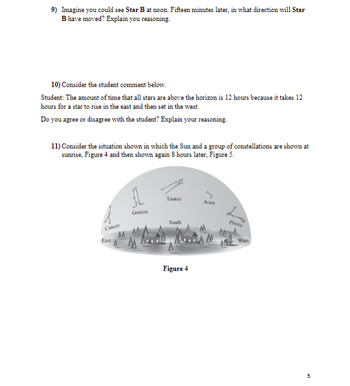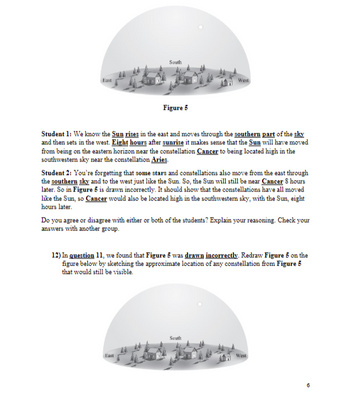
College Physics
11th Edition
ISBN: 9781305952300
Author: Raymond A. Serway, Chris Vuille
Publisher: Cengage Learning
expand_more
expand_more
format_list_bulleted
Question
thumb_up100%
Please answer all questions on page 6. There is an agree or disagree question and there's a #12 question as well. Please open the image to see page 6. Page 5 has background information.

Transcribed Image Text:### Educational Content: Astronomy
**9) Observation Exercise: Star Movement**
**Scenario:**
Imagine you could see Star B at noon. Fifteen minutes later, in what direction will Star B have moved? Explain your reasoning.
**10) Student Commentary Analysis: Star Visibility**
**Student's Comment:**
The amount of time that all stars are above the horizon is 12 hours because it takes 12 hours for a star to rise in the east and then set in the west.
**Question:**
Do you agree or disagree with the student? Explain your reasoning.
**11) Understanding Constellation Movement: Diagram Analysis**
**Scenario:**
Consider the situation in which the Sun and a group of constellations are shown at sunrise (Figure 4) and then shown again 8 hours later (Figure 5).
**Diagrams Explanation:**
**Figure 4:**
This diagram illustrates the positions of the Sun and various constellations at sunrise. The constellations, including Cancer, Gemini, Taurus, Aries, and Pisces, are positioned around the horizon, with annotated direction markers (East, South, West).
**Figure 5:**
This diagram, though not shown here, presumably illustrates the same sky 8 hours later, showing the movement of the Sun and constellations across the sky.
These figures help to visualize the apparent motion of celestial bodies due to Earth's rotation, emphasizing how the constellations and the Sun shift positions over time as observed from a fixed point on Earth.
### Reflection:
Use the diagrams and explanations above to understand the concept of celestial motion. Answer the questions by referring to the described figures and your existing knowledge of astronomy.

Transcribed Image Text:### Solar Path and Constellations: An Educational Activity
#### Understanding the Sun's Movement and Constellation Positions
**Figure 5**:
The image in Figure 5 depicts a hemispherical sky view showing the four cardinal directions: East, West, North, and South. This diagram is used to illustrate the movement of the Sun across the sky and the positioning of constellations.
#### Student Perspectives on Sun's Movement and Constellations:
**Student 1**:
"We know the Sun rises in the east and moves through the southern part of the sky and then sets in the west. **Eight hours after sunrise** it makes sense that the Sun will have moved from being on the eastern horizon near the constellation **Cancer** to being located high in the southwestern sky near the constellation **Aries**."
**Student 2**:
"You're forgetting that some stars and constellations also move from the east through the southern sky and to the west just like the Sun. So, the Sun will still be near **Cancer** 8 hours later. So, in Figure 5 is drawn incorrectly. It should show that the constellations have all moved like the Sun, so **Cancer** would also be located high in the southwestern sky, with the Sun, eight hours later."
#### Discussion and Critical Thinking:
**Do you agree or disagree** with either or both of the students? Explain your reasoning. Check your answers with another group.
#### Practical Exercise:
**Exercise 12)**:
**In question 11**, we found that Figure 5 **was drawn incorrectly**. Redraw Figure 5 on the figure below by sketching the **approximate location of any constellation from Figure 5** that would still be visible.
(Students are instructed to create their own diagram, similar to Figure 5, but correcting the positions of the constellations based on the critique provided by Student 2.)
#### Explanation:
The original diagram aims to show the Sun's movement and its relationship with certain constellations as observed from Earth. Critically engaging with these perspectives requires understanding the celestial mechanics of both solar and star movements across the sky.
This hands-on activity integrates observational skills with theoretical knowledge about astronomy. By analyzing and correcting the provided diagram, students strengthen their grasp of the diurnal motion of celestial bodies.
**Note**:
It is essential for students to visualize how the entire celestial sphere moves together from east to west due to Earth's rotation. This understanding forms the basis
Expert Solution
This question has been solved!
Explore an expertly crafted, step-by-step solution for a thorough understanding of key concepts.
This is a popular solution
Trending nowThis is a popular solution!
Step by stepSolved in 2 steps with 1 images

Knowledge Booster
Learn more about
Need a deep-dive on the concept behind this application? Look no further. Learn more about this topic, physics and related others by exploring similar questions and additional content below.Similar questions
- A convex lens produces an image with a magnification of +5. Describe the locatior size, and orientation of the image produced. Circle one from each pair of answers Same side as object/ opposite side as object Upright/Inverted Real /Virtual Enlarged /Reducedarrow_forwardWhich one is correct looking at the image? A + C = B A + B + C = 0 B + C = A A + B = Carrow_forwardSpherical refracting surfaces. An object O stands on the central axis of a spherical refracting surface. For this situation (see the table below, all distances are in centimeters), nį is the index of refraction where the object is located, n2 is the index of refraction on the other side of the refracting surface. Find (a) the image distance i, and determine whether the image is (b) real or virtual and (c) on the same side of the surface as object O or on the opposite side. (a) (b) (c) n1 n2 p ri R/V Side 1.5 1.3 +70 +56 (a) Number i Units (b) (c) > >arrow_forward
- An object is placed 12 cm in front of a convex mirror of radius 40 cm. Find the position and magnification of the image. State whether the image is real or virtual, and draw a light ray diagram to show the image.arrow_forward2. 11.3 cm,-0.4 cm 2. A concave mirror has f = 10.5 cm. An object that is 5.2 cm tall is placed 1.5 m away from the mirror. Sketch the ray diagram. Find image height and distance. Describe image.arrow_forwardShown in the figure below is a system containing two lenses and an object. The focal lengths of the two lenses are f = 15 cm %3D and f, = -7.5 cm. The two lengths indicated in the figure are L, = 22.5 cm and L2 = 12 cm. f1 f2 L2 Determine all the following about the image from the first lens only: Object distance for the first lens, do1. cm Image distance for the first lens, di1. cm Magnification of the first lens, m1. The second lens uses the image from the first lens as its object. Determine all the following about the image from the second lens: Object distance for the second lens, do1. cm Image distance for the second lens, di1. cm Magnification of the second lens, m1. Determine the magnification of the whole system, mtot. Select the correct attributes of the final image of the system: O virtual O real O shrunk O enlarged right side up O upside downarrow_forward
- Solved the mobile problem. I would also like to see your work written (or typed) on paper as much as possible also like a detail. I attach an image of the question. Please write detail to solve the solution.arrow_forwardI know it’s not real and virtual. I don’t think it’s real so I’m thinking it’s just virtual but I’m not sure.arrow_forwardThe image of the coin in the figure is magnified by a factor of M = 4.7 times, and is a distance d = 9.4 cm from the lens. What is the focal length (in cm) of the lens? cm iarrow_forward
- A certain slide projector has a 110 mm focal length lens. A. How far away is the screen (in m), if a slide is placed 115 mm from the lens and produces a sharp image? B. If the slide is 15.0 by 30.0 mm, what are the dimensions of the image? __ cm by __ cm.arrow_forwardChapter 34, Problem 034 SN When an object is placed a distance p in front of a spherical refracting surface with radius of curvature r, the image distance is i. If the index of refraction of the surrounding material Is n1, what is the index of refraction of the refracting material? State your answer in terms of the given variables. n2 = 2 Editarrow_forwardA small object is placed to the left of a convex lens and on its optical axis. The object is 46 cm from the lens, which has a focal length of 15 cm.Determine the location of the image formed by the lens. (Enter your answer in cm from the lens.) 1. cm from the lens 2. Describe the image.arrow_forward
arrow_back_ios
SEE MORE QUESTIONS
arrow_forward_ios
Recommended textbooks for you
 College PhysicsPhysicsISBN:9781305952300Author:Raymond A. Serway, Chris VuillePublisher:Cengage Learning
College PhysicsPhysicsISBN:9781305952300Author:Raymond A. Serway, Chris VuillePublisher:Cengage Learning University Physics (14th Edition)PhysicsISBN:9780133969290Author:Hugh D. Young, Roger A. FreedmanPublisher:PEARSON
University Physics (14th Edition)PhysicsISBN:9780133969290Author:Hugh D. Young, Roger A. FreedmanPublisher:PEARSON Introduction To Quantum MechanicsPhysicsISBN:9781107189638Author:Griffiths, David J., Schroeter, Darrell F.Publisher:Cambridge University Press
Introduction To Quantum MechanicsPhysicsISBN:9781107189638Author:Griffiths, David J., Schroeter, Darrell F.Publisher:Cambridge University Press Physics for Scientists and EngineersPhysicsISBN:9781337553278Author:Raymond A. Serway, John W. JewettPublisher:Cengage Learning
Physics for Scientists and EngineersPhysicsISBN:9781337553278Author:Raymond A. Serway, John W. JewettPublisher:Cengage Learning Lecture- Tutorials for Introductory AstronomyPhysicsISBN:9780321820464Author:Edward E. Prather, Tim P. Slater, Jeff P. Adams, Gina BrissendenPublisher:Addison-Wesley
Lecture- Tutorials for Introductory AstronomyPhysicsISBN:9780321820464Author:Edward E. Prather, Tim P. Slater, Jeff P. Adams, Gina BrissendenPublisher:Addison-Wesley College Physics: A Strategic Approach (4th Editio...PhysicsISBN:9780134609034Author:Randall D. Knight (Professor Emeritus), Brian Jones, Stuart FieldPublisher:PEARSON
College Physics: A Strategic Approach (4th Editio...PhysicsISBN:9780134609034Author:Randall D. Knight (Professor Emeritus), Brian Jones, Stuart FieldPublisher:PEARSON

College Physics
Physics
ISBN:9781305952300
Author:Raymond A. Serway, Chris Vuille
Publisher:Cengage Learning

University Physics (14th Edition)
Physics
ISBN:9780133969290
Author:Hugh D. Young, Roger A. Freedman
Publisher:PEARSON

Introduction To Quantum Mechanics
Physics
ISBN:9781107189638
Author:Griffiths, David J., Schroeter, Darrell F.
Publisher:Cambridge University Press

Physics for Scientists and Engineers
Physics
ISBN:9781337553278
Author:Raymond A. Serway, John W. Jewett
Publisher:Cengage Learning

Lecture- Tutorials for Introductory Astronomy
Physics
ISBN:9780321820464
Author:Edward E. Prather, Tim P. Slater, Jeff P. Adams, Gina Brissenden
Publisher:Addison-Wesley

College Physics: A Strategic Approach (4th Editio...
Physics
ISBN:9780134609034
Author:Randall D. Knight (Professor Emeritus), Brian Jones, Stuart Field
Publisher:PEARSON